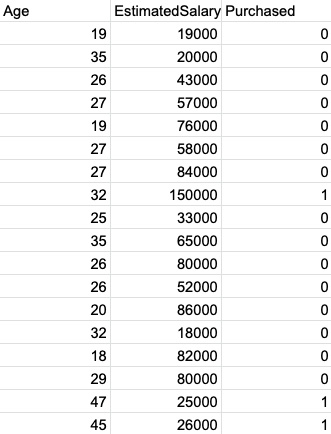Classification
Unlike regression, where you predict a continuous number, you use classification to predict a category. We will cover logistic regression here.
We will use a dataset of historical data of iPhone purchases, based on the age and the salary of the buyers, to predict whether a new potential buyer will purchase an iPhone.

Let’s do the preparation first:
import numpy as np
import pandas as pd
import matplotlib.pyplot as plt
dataset = pd.read_csv('Social_Network_Ads.csv')
X = dataset.iloc[:,:-1].values
y = dataset.iloc[:, -1].values
from sklearn.model_selection import train_test_split
X_train, X_test, y_train, y_test = train_test_split(X, y , test_size = 0.2, random_state=1)
from sklearn.preprocessing import StandardScaler
sc = StandardScaler()
X_train = sc.fit_transform(X_train)
X_test = sc.transform(X_test)
print(X_train)
[[-0.8 -1.19]
[ 0.76 -1.37]
[ 0.85 1.44]
[-0.51 -1.49]
[-1.49 0.38]
...






















































